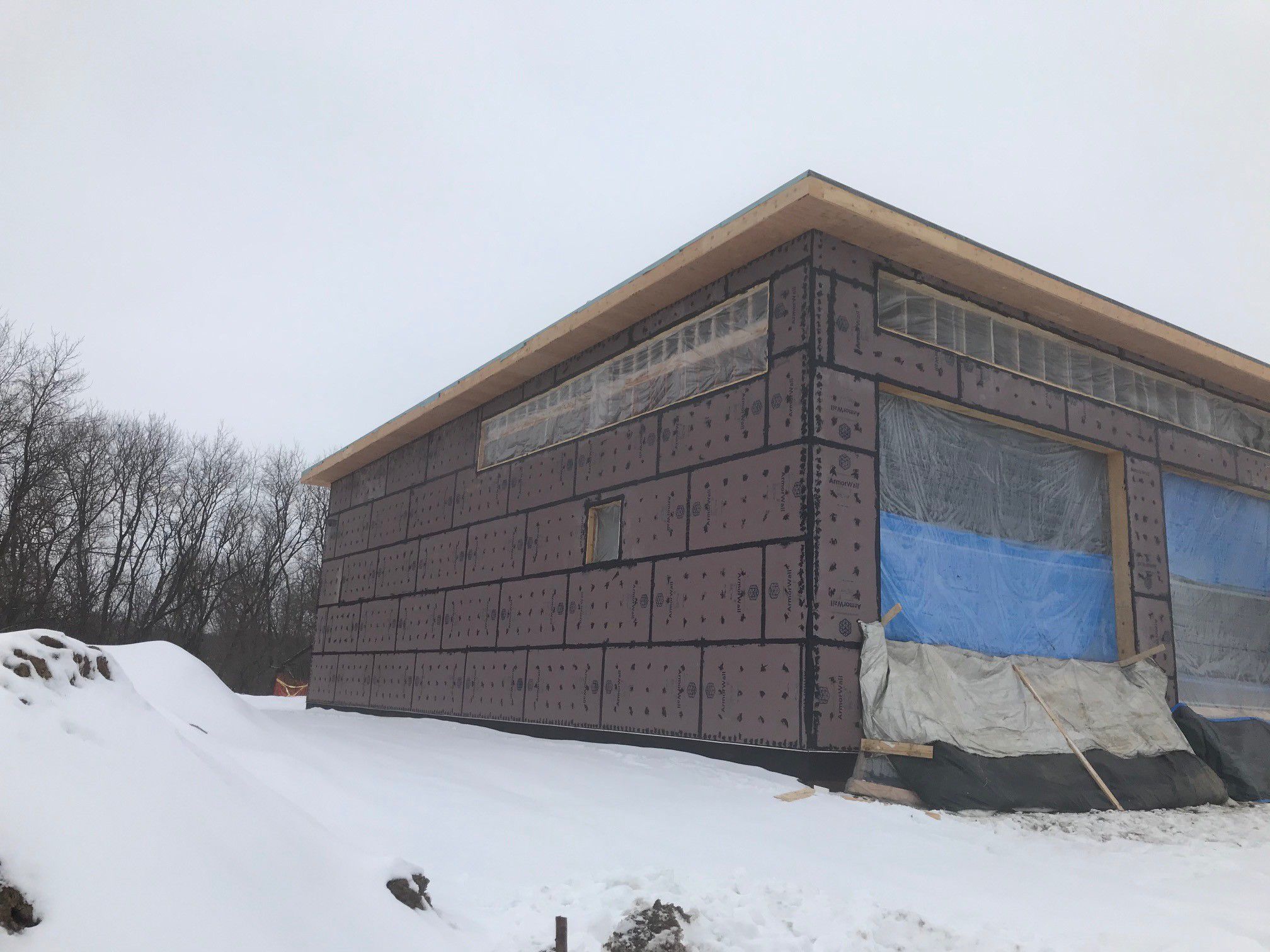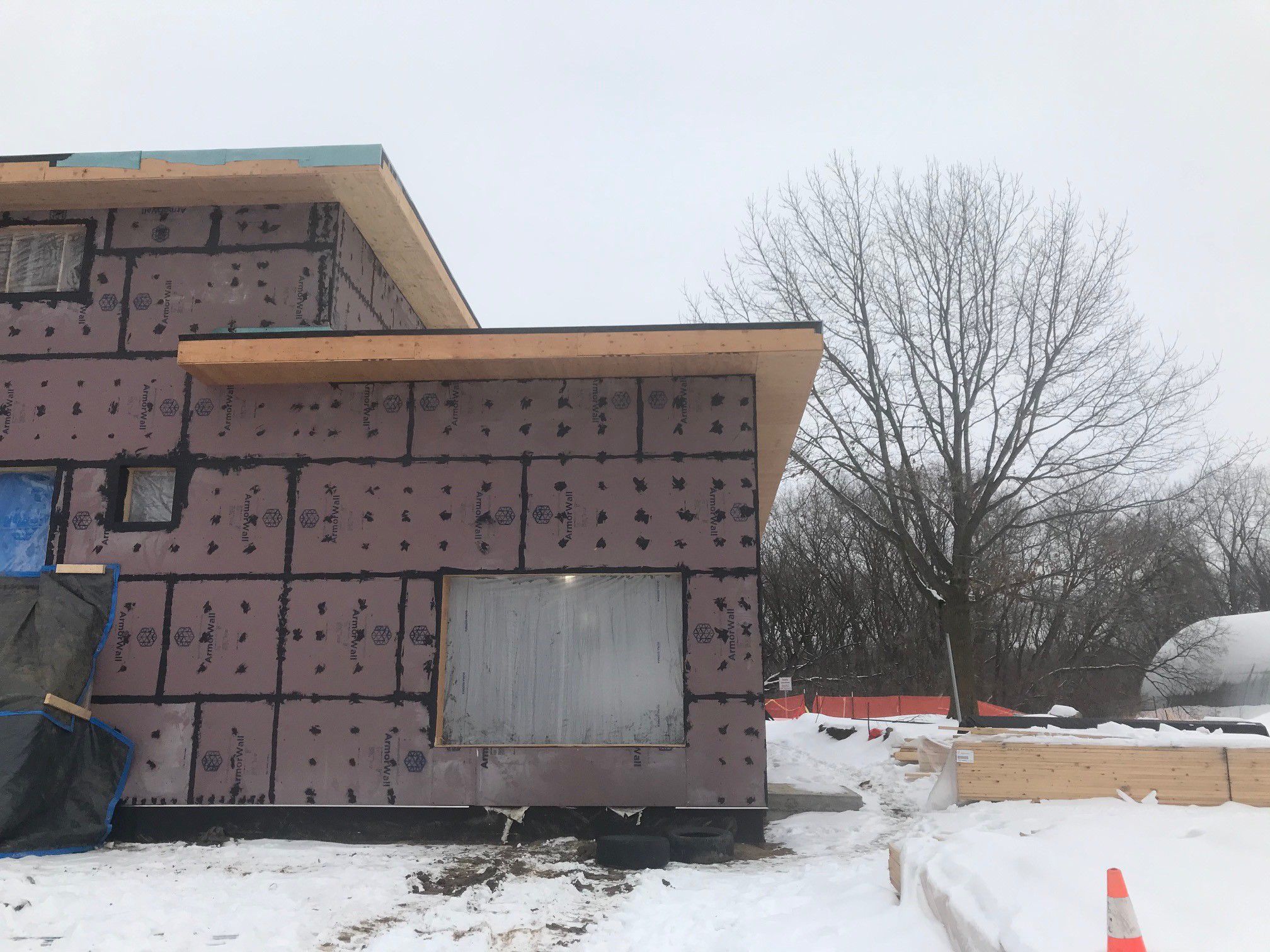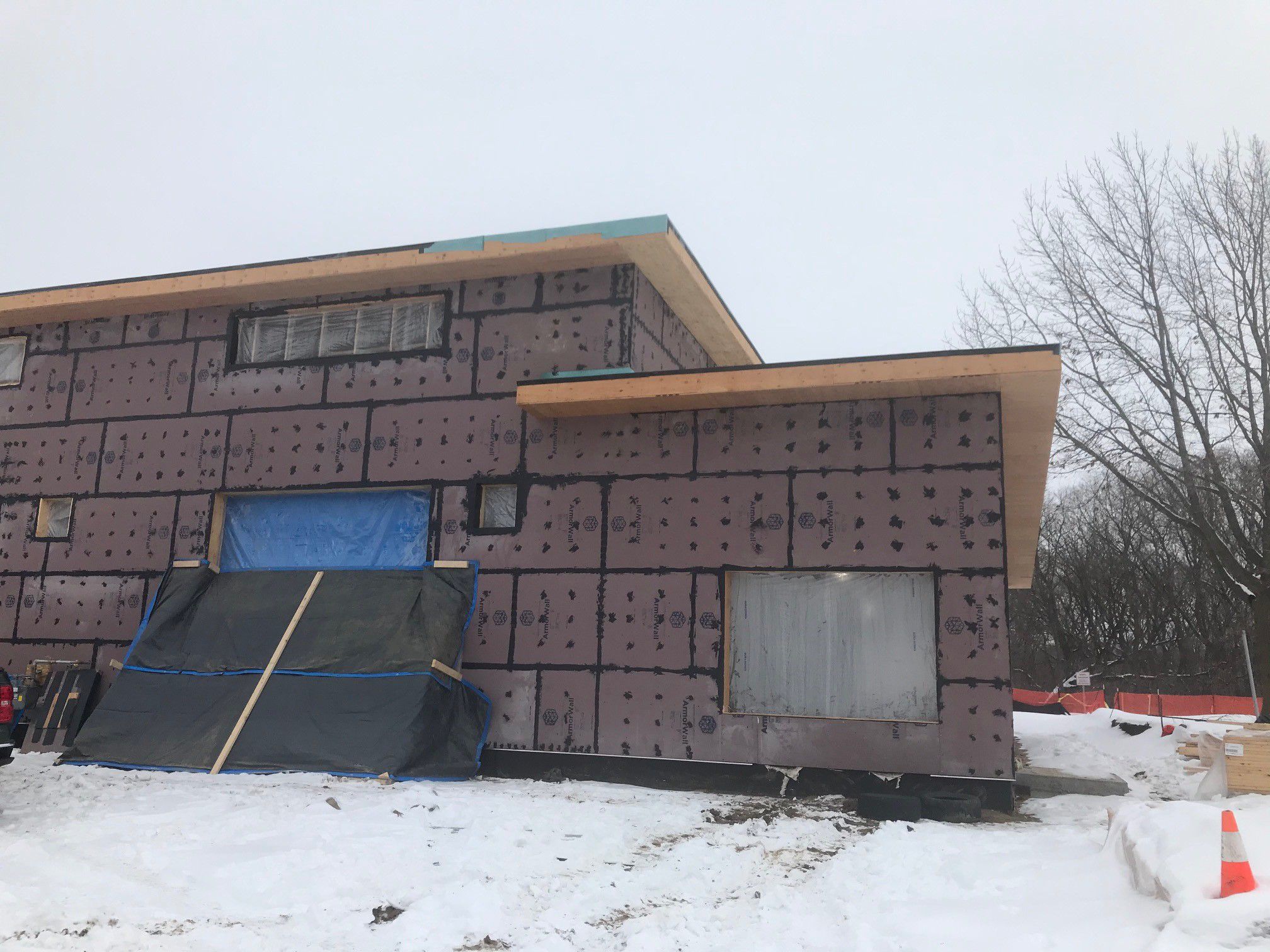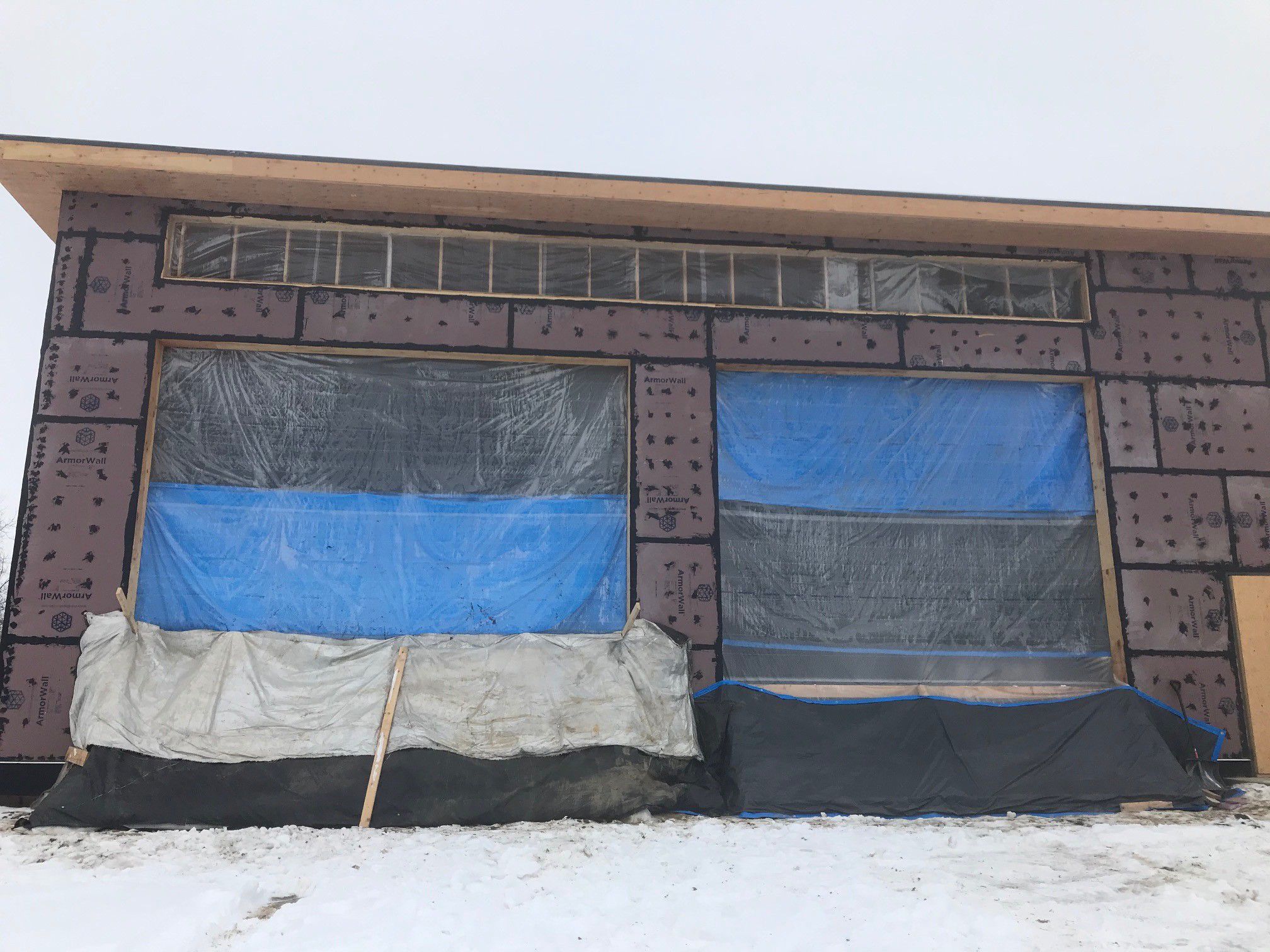<html><head><style>h1 {text-shadow: 1px 1px #111111;}</style></head><body><h1><p style="color:white"><b>Municipal Maintenance Facility<br>Prior Lake, Minnesota</b></h1></body></html></p>
Case Study
Municipal Maintenance Facility
Prior Lake, Minnesota

Building Type: Municipal, New Construction
Solution: ArmorWall Vapor Permeable (VP) and ArmorWall Below Grade (BG) Structural Insulated Sheathing
Sales Representative: Innovative Architectural Products
Architect: OERTEL ARCHITECTS, LTD.
General Contractor and Installer: Klar Dig Construction, Inc.
Summary
When construction began on this Municipal Maintenance Facility in Prior Lake, MN, the architect knew they needed a product that could withstand a cold climate with lots of snow. One of the greatest benefits of ArmorWall is its high performance in cold climate zones. By combining up to four traditional components and trades into one, the installation process is faster, less expensive, and easily adapts to harsh weather conditions. Fasteners adhere the 4’ x 8’ panels to studs or framing, sealants cover fastener holes and seams, and a variety of cladding systems are attached on a smooth and flat surface. All of this can be done in harsh weather conditions including rain, snow, and low temperatures. That’s why ArmorWall Vapor Permeable (VP) and ArmorWall Below Grade (BG) Structural Insulated Sheathing were chosen for this project.
Read our interview with architect Ron Betcher of OERTEL ARCHITECTS, LTD. in St. Paul, Minnesota to learn how ArmorWall came to be a critical solution on a new municipal maintenance facility in Prior Lake, Minnesota.
INTERVIEW
Ron Betcher, OERTEL ARCHITECTS, LTD.
Tell us about yourself and this project.
“I’ve been working at OERTEL ARCHITECTS, LTD. for more than 17 years now. I started as an intern in 2003 and am currently a Project Manager and Job Captain. Our firm was hired to design and manage the construction of a new maintenance facility building with the not so glamorous but incredibly important purpose of storing vehicles, tools, equipment, and offices for the park’s maintenance staff. While not a public building within the park, it is an important asset to the park. It’s where some of the most important equipment and supplies are located, and where staff convenes to prioritize projects that help serve the community and guests.
We had a hard time finding a product that could meet our requirements when I began looking. We chose two different types of ArmorWall for the exterior building enclosure system. Together, the two products provide the durability and continuous insulation we were looking for but came with a wealth of added benefits that resulted in cost and time savings during installation.”
Where is the building located?
“The building is located in Cleary Lake Park in Prior Lake, Minnesota, a part of the Three River Park District. The park system is near Minneapolis and St. Paul, Minnesota, the state capitol. The District was established by the Minnesota State Legislature in 1957 to manage parks and trails in the south metro area. It is governed by an independent Board of Commissioners that provides oversight for a wealth of activities including construction projects. The District has grown over the years and now manages almost 27,000 acres of park reserves, regional parks, regional trails and special-use facilities.
Within the District is Cleary Lake Regional Park, a very popular year-round recreation area that includes a golf course, campground, picnic area, cross-country ski trails, swimming beach and more. And, importantly for our project, maintenance facilities that store the vehicles, supplies, tools, equipment, and offices that ensure the park system is available year-round for citizens and visitors.”
What were your customer’s priorities?
“The District was not looking for a high-end modern design due to the nature and location of the building. To serve the purpose best, the building needed to be very durable, able to withstand our harsh winter conditions and, to ensure that the building wouldn’t be a burden on the District from a heating perspective in the winter, it needed to have a tight and well-insulated building envelope. Just like a residential house, if your building has small cracks and holes all over it, and certainly poorly insulated exterior walls, you’ll waste energy in heating and cooling seasons through high utility bills.
Another requirement for me was to avoid the use of batt insulation on the interior side of the exterior walls. When I was running energy models to determine the best and most cost-effective way to insulate the building, doing so from the inside just wasn’t working. I realized that we needed to use “outsulation”, where the insulation is on the outside of the building frame, not the inside. To do that for this project, we focused on an exterior wall system with a very high R-value for continuous insulation, made sure it would be fully sealed to prevent air and water from entering, and also that would provide structural needs of an exterior sheathing.
While the District did not provide any formal sustainability or energy efficiency requirements for the project beyond code requirements, I wanted to implement these features where I could. Implementing them can be more expensive when multiple traditional construction components are used, but fortunately, we found a cost-effective solution that offered many more additional benefits, more than we planned for, actually.
Lastly, the construction was scheduled for November through February here in Minnesota, so we needed a product that could be installed in all climate conditions, either cold winter months like what we had or hot summer days.”
How did you learn about ArmorWall?
“Minnesota’s energy code recently added a requirement for continuous insulation that was challenging on a recent project, so I was looking for solutions on my next projects. Fortunately, Tracy Martin of Innovative Architectural Products introduced me to ArmorWall at just the right time. She and I have worked together on several commercial projects before and stay in touch for exactly this reason.
Tracy represents several manufacturer product lines that we use for different needs on different projects and she helps our firm stay current on new products that help address code and other challenges and innovations that help me deliver the best projects for my clients. Tracy and I were talking about this project during a regular meeting on a different product and she handed me a 2 ½” sample of ArmorWall. Holding this thick, sturdy, and well-insulated sample in my hand led us to discuss the needs of this project in greater detail and determine if ArmorWall could be a solution. When she shared with me the ArmorWall BG product for below grade usage, which incorporates factory-made waterproofing on the panels themselves - which is traditionally applied on-site by a separate trade - I knew that we were on to something good. But I knew that we would need something thicker with more R-value, and fortunately ArmorWall can customize the thickness for projects like ours.
It’s always nice to have a full system like ArmorWall to get rid of the finger pointing on a project. If something were to go wrong, everyone’s not standing in a circle wasting time pointing at each other. We would know what happened and how to fix it. Finger pointing wasn’t an issue on this project.”
How did ArmorWall help meet code?
“As energy code requirements for continuous insulation on the exterior continue to increase, architects like myself are looking to meet that requirement as cost-effectively as we possibly can. Adding more insulation on the exterior of the wall - again “outsulation” - you need to consider impacts and opportunities in other related areas. One to consider is where the water-resistant barrier (WRB) will be and what materials it will be comprised of.
In some cases, using an innovative product like ArmorWall moves layers around and need to be accounted for. They can, of course, but you need an engineering team like the staff for ArmorWall to provide the technical details to make sure it’s right. In the case of our project, we wanted to try to get the dewpoint out of the wall cavity and into a vapor impermeable material like rigid foam and not batt insulation. Using an “outsulation” product like ArmorWall makes things easier.
We were able to provide the technical specifications to the Code Official and have him agree that with ArmorWall and the WRB together, we didn’t need an interior vapor barrier. What that means is that we didn’t need the interior of the building to be wrapped in plastic as a result. That’s not only good building science but also more time savings, cost savings and one less part of the project to worry about.”
How did the installation go?
“Because it was our team’s first time using ArmorWall, it definitely took some getting used to. The system is just so different - in very good ways - than what our installation crew was used to. We had to establish trust in the process early to make sure we were doing it right. To help with that process, I made sure that we setup a mock wall and had Tracy and Jarrett Davis, National Technical & Building Science Director, there to assist in the process.
The training was short and simple, surprising us all. After the initial training, the general contractor performed the installation themselves and took their time to get used to the fastening process with ArmorWall - they just hadn’t seen anything like it before.
Another unique benefit of ArmorWall is that it’s installed using traditional tools and methods: a regular screw gun for the fasteners, a regular circular saw to cut the panels, and specialized sealant that goes on just like any other. But because the crew was used to four separate materials and installation steps with other products, it took some getting used to. This installation worked out well with some lessons learned along the way. Our next one would help us realize all of those time and cost savings available.”
What surprised you about the install?
“One of the criteria I didn’t mention earlier is that the customer and I wanted to use local contractors on this project. Given the location, size, and economies of scale of the project, we felt and would be in the best interest to use local companies and workers. What surprised us was that just one company and one crew would be needed for the installation.
Because of how ArmorWall works, essentially combining up to four traditional envelope components that are installed by two or three different crews into one, we only needed one company to train on the installation process and do the work. And, that one company only needed to do one revolution around the building to complete the install for each of the two ArmorWall components.
Normally, that job would be done by up to four different specialty crews and four revolutions around the building at different times. With ArmorWall, any crew that handles normal carpentry, drywall or cladding projects can handle the installation - they don’t need to be a specialty contractor.
Did ArmorWall enable a better design?
“Definitely. Meeting the continuous insulation requirements with one product streamlines the design, which is helpful. Another area that ArmorWall addressed involved the shear requirements of the building design. Given the cold winters, blowing wind and snow accumulation, we needed the exterior walls to be rated to a high shear level. This may have been the best benefit of this building envelope system. Had we needed to put up an additional layer of sheathing to get our needed shear, we would have needed a different product. But, with ArmorWall, it serves as the shear-rated layer. Additional layers of insulation or plywood were not needed.”
Photos




